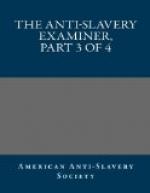Rev. JOSEPH M. SADD, of Castile, N.Y., who has lately left Missouri, where he was pastor of a church for some years, says:—
“In one case, near where we lived, a runaway slave, when brought back, was most cruelly beaten—bathed in the usual liquid—laid in the sun, and a physician employed to heal his wounds:—then the same process of punishment and healing was repeated, and repeated again, and then the poor creature was sold for the New Orleans market. This account we had from the physician himself.”
MR. ABRAHAM BELL, of Poughkeepsie, New York, a member of the Scotch Presbyterian Church, was employed, in 1837 and 38, in levelling and grading for a rail-road in the state of Georgia: he had under his direction, during the whole time, thirty slaves. Mr. B. gives the following testimony:—
“All the slaves had their backs scarred, from the oft-repeated whippings they had received.”
Mr. ALONZO BARNARD, of Farmington, Ohio, who was in Mississippi in 1837 and 8, says:—
“The slaves were often severely whipped. I saw one woman very severely whipped for accidentally cutting up a stalk of cotton.[8] When they were whipped they were commonly held down by four men: if these could not confine them, they were fastened by stakes driven firmly into the ground, and then lashed often so as to draw blood at each blow. I saw one woman who had lately been delivered of a child in consequence of cruel treatment.”
[Footnote 8: Mr. Cornelius Johnson, of Farmington, Ohio, was also a witness to this inhuman outrage upon an unprotected woman, for the unintentional destruction of a stalk of cotton! In his testimony he is more particular, and says, that the number of lashes inflicted upon her by the overseer was “ONE HUNDRED AND FIFTY.”]
Rev. H. LYMAN, late pastor of the Free Presbyterian Church at Buffalo, N.Y. says:—
“There was a steam cotton press, in the vicinity of my boarding-house at New Orleans, which was driven night and day, without intermission. My curiosity led me to look at the interior of the establishment. There I saw several slaves engaged in rolling cotton bags, fastening ropes lading carts, &c.
“The presiding genius of the place was a driver, who held a rope four feet long in his hand, which he wielded with cruel dexterity. He used it in single blows, just as the men were lifting to tighten the bale cords. It seemed to me that he was desirous to edify me with a specimen of his authority; at any rate the cruelty was horrible.”
Mr. JOHN VANCE, a member of the Baptist Church, in St. Albans, Licking county, Ohio, who moved from Culpepper county, Va., his native state in 1814, testifies as follows:—
“In 1826, I saw a woman by the name of Mallix, flog her female slave with a horse-whip so horribly that she was washed in salt and water several days, to keep her bruises from mortifying.




